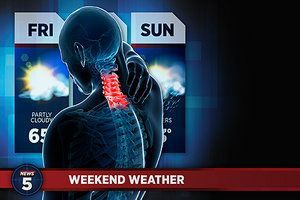Some doctors thrive in a personality-based clinic and have a loyal following no matter what services or equipment they offer, but for most chiropractic offices who are trying to grow and expand, new equipment purchases help us stay relevant and continue to service our client base in the best, most up-to-date manner possible. So, regarding equipment purchasing: should you lease, get a bank loan, or pay cash?
Pain in the Forecast
It's a running joke in our clinic that the most accurate method of predicting storms is to see how full the waiting room is. But why do some patients seem to be able to predict coming rains based on their aches and pains? It's a question I hear from my patients every time weather changes are on the horizon. It's true that many people with back pain, neck pain or other joint complaints are often surprisingly accurate in predicting when storms are approaching, and believe it or not, there is some validity to their weather forecasting abilities.
The phenomenon is nothing new. As early as the 5th century B.C., Hippocrates suggested many illnesses were related to changes in the weather. Since then, a number of musculoskeletal disorders have been identified as being especially sensitive to changing weather conditions, including osteoarthritis, tension headaches, back pain and fibromyalgia.
A variety of meteorologic factors have been suggested as the culprit, including temperature, precipitation, humidity, thunderstorms and increased ionization of the air. But while reliable conclusions about the link between weather and musculoskeletal pain have yet to be established due to the lack of controlled studies, most research points to the lowered atmospheric barometric pressure that often precedes storms and other weather changes.

In one of the first empirical studies on the effect of weather on joint pain, published in 2010 by the International Journal of Biometeorology, researchersestablished a direct connection between low barometric pressure, inflammation and joint pain in rats.1 For the study, scientists artificially produced a state of chronic inflammation in the feet of lab rats, mimicking the clinical features of neuropathic pain in humans. When the rats were placed in a low-pressure environment, they exhibited signs of exacerbated foot joint pain not seen in their control counterparts.
Additional research has demonstrated the same phenomenon occurs in humans. For instance, a 2002 study from the Journal of Spinal Disorders and Techniques concluded that "back pain may be aggravated by atmosphere depression in patients with lumbar disc disease."2 And a 2007 study from the American Journal of Medicine determined that "changes in barometric pressure are independently associated with osteoarthritis knee pain severity."3
Various mechanisms have been proposed to account for this relationship, but the most likely explanation involves the expansion of fluid in swollen joints following fluctuations in barometric pressure. Inflammation due to dysfunction, disease or injury will lead to edema in and surrounding a joint. Because materials of varying densities are affected differently by pressure changes, drops in barometric pressure expand this extra fluid more than the muscle, ligaments and connective tissue that make up the joint capsule, stretching sensitized tissues and activating a nociceptive response.
A good illustration for patients is a balloon in a barometric chamber. If the pressure outside the balloon drops, the air on the inside expands and stretches the walls of the balloon. When the same happens to a swollen joint, the expansion stretches soft tissue, irritates nerve endings and causes pain.
It's important to note that this contraction and expansion of excess fluid in joints is happening on such a small scale that it cannot be quantified by any scientific means and the process is therefore entirely theoretical. But whatever the mechanism, the takeaway is that some degree of inflammation must already exist, whether we are aware of it or not, for barometric pressure changes to lead to joint pain. Weather changes can't cause pain by themselves; they can only exacerbate inflammation that's already there. After all, not everyone experiences pain when a storm is brewing, and those who do don't experience pain in every joint.
It really drives home what chiropractors have been saying for decades: The absence of pain isn't the same as good health! So while there's validity to the idea of "aches and pains mean coming rains," anticipation of weather changes shouldn't interfere with patients' motivation to decrease underlying inflammation with the things they actually can control. Sunny days ahead are no substitution for proper exercise, good diet and supplementation, and regular chiropractic care.
References
- Funakubo M, Sato J, Obata K, Mizumura K. The rate and magnitude of atmospheric pressure change that aggravate pain-related behavior of nerve injured rats. Int J Biometeorol, 2011 May; 55(3):319-26.
- Kasai Y, Takegami K, Uchida A. Change of barometric pressure influences low back pain in patients with vacuum phenomenon within lumbar intervertebral disc. J Spinal Disord Tech, 2002 Aug; 15(4):290-3.
- McAlindon T, Formica M, Schmid CH, Fletcher J. Changes in barometric pressure and ambient temperature influence osteoarthritis pain. Am J Med, 2007 May; 120(5):429-34.



